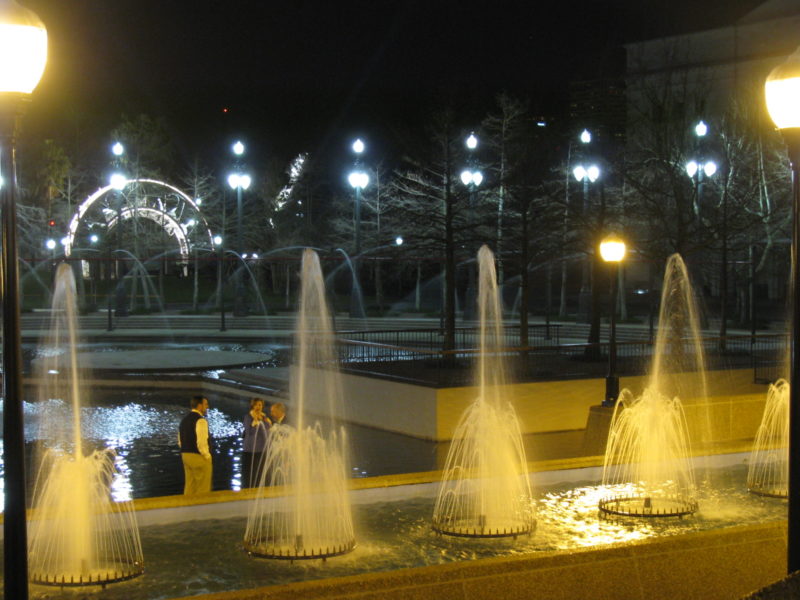
The exterior of the Mahalia Jackson Theatre. Photo by Nola Agent via Flickr.
The Mahalia Jackson Theater for the Performing Arts is an entertainment venue located in New Orleans, Louisiana. The Theater derives its name from the famed New Orleanian gospel singer Mahalia Jackson. It took some major damage after the devastating Hurricane Katrina, but it has since made a full recovery. The theater seats 2,100 people, making it one of the largest theaters for the performing arts in the city. It is a popular venue for many different types of performances. These include ballet productions, traveling Broadway plays and musicals, musical concerts, and operas (“The Mahalia Jackson Theater.” Mahalia Jackson Theater. Arts Center Enterprises – New Orleans, LLC, 2010. Web. 27 Oct. 2011).
History
The theater was first opened in 1973 under the name “The New Orleans Theater for the Performing Arts”. The theater was home to the New Orleans Opera Association as well as the New Orleans Ballet Association. Its 2,100 seats were filled up with those citizens of New Orleans who sought to be entertained by some of the finest performers in the city. The types of performers who were often known to play there were jazz and gospel singers, brass bands, ballet companies, and other performers of the fine arts. The Theater was originally scheduled for its grand opening to be on September 26, 1972, but the opening was delayed all the way till January 9, 1973.
The first performance to play at the theater was The New Orleans Philharmonic Symphony Orchestra, and they entertained a full house with Giuseppe Verdi’s “Manzoni Requiem”. It is located in Louis Armstrong Park at on North Rampart Street, just north of the historic French Quarter district. The chandelier in the foyer cost $32,000 to have built handmade in Venice, Italy. The entire Theater’s cost of production was totaled at $8,535,000. William Bergman, the architect of the building, claimed upon its completion that it was one of the finest Theaters in the United States (The Times Picayune. 10 Jan. 1973. 57. Print).
Mahalia Jackson
Mahalia Jackson was born in New Orleans, Louisiana. She was born into poverty, and until the age of sixteen, she lived in an uptown neighborhood near Tulane University. At this age, she moved north to Chicago, Illinois (“Mahalia Jackson.” Mahalia Jackson Theater. Arts Center Enterprises – New Orleans, LLC, 2010. Web. 27 Oct. 2011). This is where her career really began to prosper. After singing for a local church in the choir, she scored a record label and made it big. She eventually became known around the world as the Queen of Gospel music. After collapsing in 1971 on tour in Munich, she died early the next year of heart complications in her home in Chicago (“Mahalia Jackson.” Women in History: Living Vignettes from Notable Women in US History. Web. 22 Nov. 2011).
In 1995, the New Orleans City Council and Mayor Marc Morial, with grants from New Orleans Jazz and Heritage Foundation and the Louisiana Division of the Arts, renamed the New Orleans Theater for the Performing Arts after the New Orleans-born singer. On the morning of October 17, 1995, the Youth Inspirational Choir and Gospel Is Alive joined with five New Orleans public school choirs in a grand opening program devoting the theater to the beloved gospel singer. The New Orleans Opera and New Orleans Ballet also participated in the event (“Choirs Set in Ceremony for Theater Dedication.” The Times Picayune. 14 Oct. 1995, B5. Print).
Hurricane Katrina
Late August of 2005 brought about a huge change in the city of New Orleans. Hurricane Katrina left much of the city underwater for days on end. Many of the buildings around the city were damaged, some beyond repair. One building that took on a good deal of water was the Mahalia Jackson Theater. Located in Louis Armstrong Park, just out of the French Quarter, the basement of the theater held water for days after the storm passed. This is the area that holds much of the mechanical working parts of the stage as well as much of the equipment. The theater also sustained some fairly problematic wind damage, such as a large broken window pane and some roof damage (“Triumphant Return.” Mahalia Jackson Theater. Arts Center Enterprises. New Orleans, LLC, 2010. Web. 26 Nov. 2011).
The first man on the scene, however, remained optimistic. Robert Lyall, director for the New Orleans Opera Association walked into the theater with high hopes. He was delighted to see that the theater only had a few damp spots here and there until he opened the door to the basement and saw nearly fourteen feet of water. Nevertheless, he had high hopes for his beloved hub for the performing arts, and he took the rebuilding of his empire as a duty (MacCash, Doug. “A Matter of Time”. Times Picayune 25 September 2005, C09. Print). True to Lyall’s prediction, the theater has definitely made a comeback. Since the storm, the theater has reopened. The city also took this chance to revamp the aging building. Millions of dollars were spent renovating the theaterâs sound system, seating, lighting, etc. This theater has made not only a recovery, but has become better from the hurricane. Unlike other venues in New Orleans like the Saenger Theater, the Mahalia Jackson Theater for the Performing Arts was revamped because of the city’s need of this cultural center.





